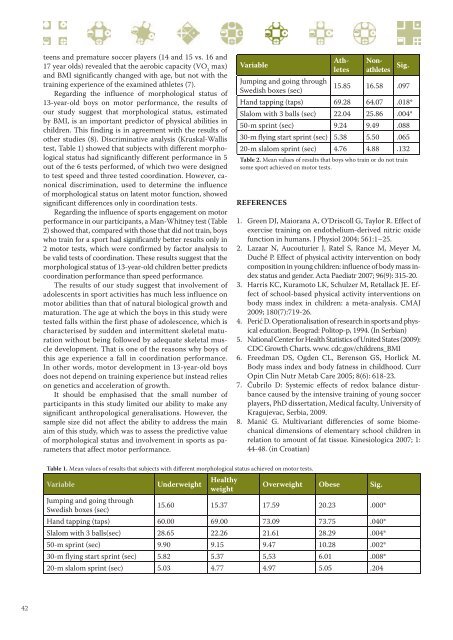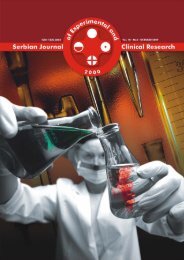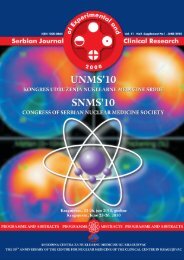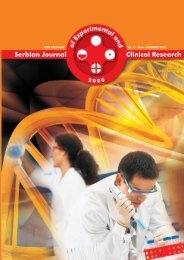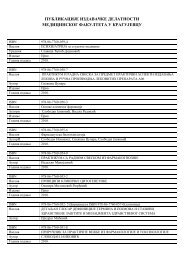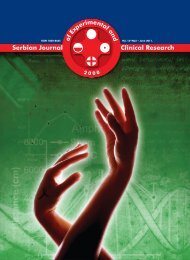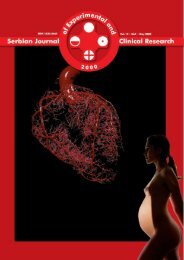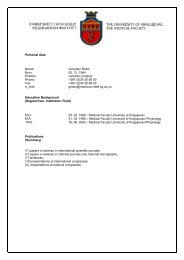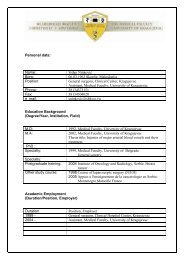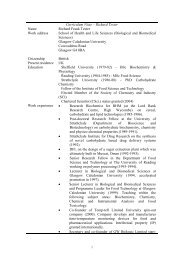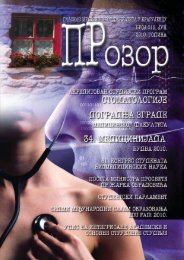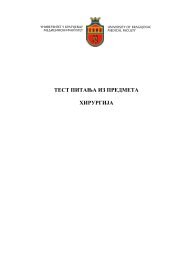neurotoxicity and mechanisms of induced hyperexcitability
neurotoxicity and mechanisms of induced hyperexcitability
neurotoxicity and mechanisms of induced hyperexcitability
You also want an ePaper? Increase the reach of your titles
YUMPU automatically turns print PDFs into web optimized ePapers that Google loves.
teens <strong>and</strong> premature soccer players (14 <strong>and</strong> 15 vs. 16 <strong>and</strong>17 year olds) revealed that the aerobic capacity (VO 2max)<strong>and</strong> BMI significantly changed with age, but not with thetraining experience <strong>of</strong> the examined athletes (7).Regarding the influence <strong>of</strong> morphological status <strong>of</strong>13-year-old boys on motor performance, the results <strong>of</strong>our study suggest that morphological status, estimatedby BMI, is an important predictor <strong>of</strong> physical abilities inchildren. This finding is in agreement with the results <strong>of</strong>other studies (8). Discriminative analysis (Kruskal-Wallistest, Table 1) showed that subjects with different morphologicalstatus had significantly different performance in 5out <strong>of</strong> the 6 tests performed, <strong>of</strong> which two were designedto test speed <strong>and</strong> three tested coordination. However, canonicaldiscrimination, used to determine the influence<strong>of</strong> morphological status on latent motor function, showedsignificant differences only in coordination tests.Regarding the influence <strong>of</strong> sports engagement on motorperformance in our participants, a Man-Whitney test (Table2) showed that, compared with those that did not train, boyswho train for a sport had significantly better results only in2 motor tests, which were confirmed by factor analysis tobe valid tests <strong>of</strong> coordination. These results suggest that themorphological status <strong>of</strong> 13-year-old children better predictscoordination performance than speed performance.The results <strong>of</strong> our study suggest that involvement <strong>of</strong>adolescents in sport activities has much less influence onmotor abilities than that <strong>of</strong> natural biological growth <strong>and</strong>maturation. The age at which the boys in this study weretested falls within the first phase <strong>of</strong> adolescence, which ischaracterised by sudden <strong>and</strong> intermittent skeletal maturationwithout being followed by adequate skeletal muscledevelopment. That is one <strong>of</strong> the reasons why boys <strong>of</strong>this age experience a fall in coordination performance.In other words, motor development in 13-year-old boysdoes not depend on training experience but instead relieson genetics <strong>and</strong> acceleration <strong>of</strong> growth.It should be emphasised that the small number <strong>of</strong>participants in this study limited our ability to make anysignificant anthropological generalisations. However, thesample size did not affect the ability to address the mainaim <strong>of</strong> this study, which was to assess the predictive value<strong>of</strong> morphological status <strong>and</strong> involvement in sports as parametersthat affect motor performance.VariableREFERENCESAthletesNonathletesSig.Jumping <strong>and</strong> going throughSwedish boxes (sec)15.85 16.58 .097H<strong>and</strong> tapping (taps) 69.28 64.07 .018*Slalom with 3 balls (sec) 22.04 25.86 .004*50-m sprint (sec) 9.24 9.49 .08830-m flying start sprint (sec) 5.38 5.50 .06520-m slalom sprint (sec) 4.76 4.88 .132Table 2. Mean values <strong>of</strong> results that boys who train or do not trainsome sport achieved on motor tests.1. Green DJ, Maiorana A, O’Driscoll G, Taylor R. Effect <strong>of</strong>exercise training on endothelium-derived nitric oxidefunction in humans. J Physiol 2004; 561:1–25.2. Lazaar N, Aucouturier J, Ratel S, Rance M, Meyer M,Duché P. Effect <strong>of</strong> physical activity intervention on bodycomposition in young children: influence <strong>of</strong> body mass indexstatus <strong>and</strong> gender. Acta Paediatr 2007; 96(9): 315-20.3. Harris KC, Kuramoto LK, Schulzer M, Retallack JE. Effect<strong>of</strong> school-based physical activity interventions onbody mass index in children: a meta-analysis. CMAJ2009; 180(7):719-26.4. Perić D. Operationalisation <strong>of</strong> research in sports <strong>and</strong> physicaleducation. Beograd: Politop-p, 1994. (In Serbian)5. National Center for Health Statistics <strong>of</strong> United States (2009):CDC Growth Charts. www. cdc.gov/childrens_BMI6. Freedman DS, Ogden CL, Berenson GS, Horlick M.Body mass index <strong>and</strong> body fatness in childhood. CurrOpin Clin Nutr Metab Care 2005; 8(6): 618-23.7. Čubrilo D: Systemic effects <strong>of</strong> redox balance disturbancecaused by the intensive training <strong>of</strong> young soccerplayers, PhD dissertation, Medical faculty, University <strong>of</strong>Kragujevac, Serbia, 2009.8. Manić G. Multivariant differencies <strong>of</strong> some biomechanicaldimensions <strong>of</strong> elementary school children inrelation to amount <strong>of</strong> fat tissue. Kinesiologica 2007; 1:44-48. (in Croatian)Table 1. Mean values <strong>of</strong> results that subjects with different morphological status achieved on motor tests.VariableUnderweightHealthyweightOverweight Obese Sig.Jumping <strong>and</strong> going throughSwedish boxes (sec)15.60 15.37 17.59 20.23 .000*H<strong>and</strong> tapping (taps) 60.00 69.00 73.09 73.75 .040*Slalom with 3 balls(sec) 28.65 22.26 21.61 28.29 .004*50-m sprint (sec) 9.90 9.15 9.47 10.28 .002*30-m flying start sprint (sec) 5.82 5.37 5,53 6.01 .008*20-m slalom sprint (sec) 5.03 4.77 4.97 5.05 .20442


